How to replace a refrigerator temperature control board

This DIY repair guide gives step-by-step instructions for replacing a temperature control board in a refrigerator. The temperature control board, also called the main control board or the PCB board, is next to the compressor, behind the panel on the back of the refrigerator. The temperature control board monitors the temperature sensors and starts the compressor and fans to cool the refrigerator. It also controls the defrost cycle. A failed temperature control board misreads the temperature sensors, causing inconsistent refrigerator temperature—typically too cold.
Because other problems can cause the same symptom, a reliable diagnosis requires the expertise of a local refrigerator repair expert. If the temperature control board is faulty, replace it with the manufacturer-approved replacement part for your model.
Use this procedure to replace the temperature control board in Kenmore, GE, Maytag, Amana, Frigidaire, Electrolux, Whirlpool and Haier refrigerators.
Instructions
- 01.
Shut off the power and water supply
Safely store any food that could deteriorate while the refrigerator is shut off for this repair. Then unplug the refrigerator or shut off the circuit breaker for the refrigerator.
Close the water supply cut-off valve for the icemaker and dispenser. The valve is often on the wall behind the refrigerator, but could be attached to a water pipe under the kitchen sink or in the basement below the fridge.
- 02.
Disconnect the water supply line
Pull the refrigerator away from the wall so you can access the water line connection and have room to work behind the refrigerator. Place a towel under the water valve assembly to catch water. Loosen the nut on the supply water line until the water line is free.
Tip: If needed, refer to the owner's manual for additional guidance with disconnecting the water line connection.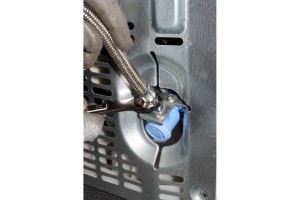
PHOTO: Disconnect the water supply line.
- 03.
Remove the back panel
Use a Phillips screwdriver to remove the screws that secure the bottom service panel to the back of the refrigerator. Remove the back panel.
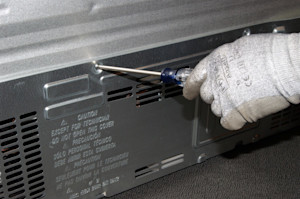
PHOTO: Remove the back panel screws.
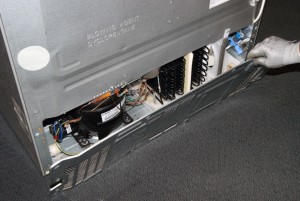
PHOTO: Remove the back panel.
- 04.
Remove the housing cover
Remove the screw that secures the cover to the temperature control board housing. Pull the cover off.
- 05.
Disconnect the wires
Document the location of wires attached to the existing temperature control board—you can label them with tape, or take a digital picture.
Disconnect the wires; if they have locking tabs; use a slot screwdriver to release the wires.
- 06.
Remove the control board
Remove the mounting screws and locking clips that secure the control board in the housing. Remove the control board.
- 07.
Install the new control board
Insert the new temperature control board and engage the locking clips. Reinstall the mounting screws.
Tip: Before handling the new temperature control board, touch the metal refrigerator cabinet or wear a grounding strap to prevent static discharge from damaging the new control board. - 08.
Connect the wires
Connect the wires to the new temperature control board, using your labels or digital photo as a guide.
- 09.
Reinstall the covers
Position the housing cover on the top of the control housing and reinstall the mounting screw. Place the bottom back panel on the back of the refrigerator so that the screw holes line up. Insert the screws and tighten them firmly.
- 10.
Reconnect the water supply line
Wrap a small amount of pipe thread tape around the water supply line fitting on the back of the water valve. Fit the water line into the water valve assembly and tighten the compression nut firmly. Open the water supply cut-off valve. If the fitting leaks, tighten the compression nut and check again.
- 11.
Restore electrical power and water supply
Plug in the refrigerator or turn on the house circuit breaker to restore power.
Most common symptoms to help you fix your refrigerators
Choose a symptom to see related refrigerator repairs.
Main causes: control board or cold control failure, broken compressor start relay, compressor motor failure, defrost tim…
Main causes: jammed ice cubes, broken ice maker assembly, dirty water filter, kinked water line, bad water valve, freeze…
Main causes: water valve leaking, frozen or broken defrost drain tube, overflowing drain pan, cracked water system tubin…
Main causes: damaged door seal, faulty defrost sensor or bi-metal thermostat, broken defrost heater, bad defrost timer o…
Main causes: blocked vents, defrost system problems, evaporator fan failure, dirty condenser coils, bad sensors, condens…
Main causes: blocked air vents, compressor problems, condenser or evaporator fan not working, control system failure, se…
Main causes: leaky door gasket, defrost system failure, evaporator fan not running, dirty condenser coils, condenser fan…
Things to do: clean condenser coils, replace the water filter, clean the interior, adjust doors to prevent air leaks, cl…
Most common repair guides to help fix your refrigerators
These step-by-step repair guides will help you safely fix what’s broken on your refrigerator.
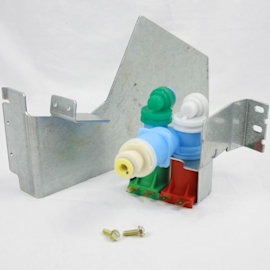
How to replace a refrigerator water valve
Replace the water valve that feeds water to the ice maker and water dispenser if it no longer controls the flow of water…

How to clean refrigerator condenser coils
Help your refrigerator run more efficiently by cleaning the condenser coils. It's easy and takes just a few minutes.…
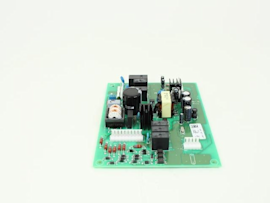
How to replace a refrigerator temperature control board
If the temperature in your refrigerator doesn't match the temperature you set, the problem could be the temperature cont…
Effective articles & videos to help repair your refrigerators
Use the advice and tips in these articles and videos to get the most out of your refrigerator.
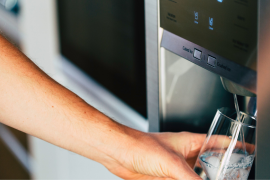
No matter what style Maytag refrigerator you have, we can walk you through replacing the water filter.…

Learn about all the convenient features on our Sears PartsDirect website that make your parts purchases easier.…

Get tips and advice on replacing the water filter in your LG refrigerator.…
